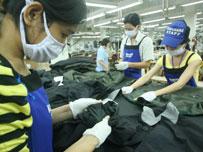 Thanh Nien Weekly: Vietnam’s textile and apparel industry failed to meet its goal of shipping US$10.5 billion in goods for 2009 as its exports were worth $9.1 billion. Can this be considered a major failure?
Thanh Nien Weekly: Vietnam’s textile and apparel industry failed to meet its goal of shipping US$10.5 billion in goods for 2009 as its exports were worth $9.1 billion. Can this be considered a major failure?
Diep Thanh Kiet: Yes, what we obtained from exports last year was lower than our goal a year earlier and even the target adjusted a half year later. However, I think it was not a failure. On the other hand, we consider the result a significant success for the industry amid the global economic downturn throughout 2009. For international trade, a slump of 5 to 8 percent in textiles and apparel sales was forecast for the whole year while Vietnam’s exports of these products slumped only 1 percent. This gap is huge, meaning the textile and garment industry drop was not huge. Especially when we consider that the corresponding fall in China was reported at 10 percent.
Secondly, the industry’s slump in exports was not as bad as in other industries like fisheries and shoes. Vietnam’s exports averagely fell by 12 percent last year. We could say the industry with a 1 percent drop in exports stood firmly and battled the crisis successfully.
Was the success against the crisis due to strong competitiveness or God smiling on local exporters?
The firm stand was rooted in the efforts of local businesses and their clients’ confidence in them. It also had to do with changes by their rivals in other exporting countries. First, as for the changes by exporting countries, China was the strongest example among them. The Chinese government led a strategy to restructure its economy, which aimed at a switch from labor-intensive to high level industries and the country witnessed a sharp drop in garment manufacturing last year. As a result, it created a big gap in supply to the global market and Vietnam was an alternative to fill the void as a neighboring area to China. Local businesses thus avoided a sharp fall in orders placed by international importers.
Second, the US still remained Vietnam’s strongest market as it accounted for 54 percent of Vietnam’s textile and apparel exports last year. US clients did not switch to other markets to avoid the impacts of the crisis but retained Vietnam as an outsourcing venue, in which they had spent money and years investing.
Third, local businesses received orders from international clients who believed that firms here were more socially and environmentally responsible than their rivals in China, Bangladesh and India.
A representative from the American Chamber of Commerce in Vietnam said Vietnam was losing its competitive advantage due to higher labor costs coupled with lower production capacities. What are your reactions to that statement?
The comment did not represent the Vietnamese textile and apparel industry. If it was right, how can you explain our [positive] export results last year? It was true to say that increasing labor cost is not an advantage for investors in textiles and apparel or labor-intensive industries in Vietnam. However, it was wrong because higher labor costs are limited to big cities like Ho Chi Minh City. Labor cost is still attractive in many provinces though it might not be advantageous in HCMC.
Vietnam’s textile and apparel industry is implementing a strategy to improve its factory capacity while at the same time raise living conditions for laborers. We do not consider low labor costs a competitive advantage. We instead focus on high-quality, value-added products in order to compete with other exporting countries. To achieve the goal, we have to improve living conditions for our employees, which in turn will enhance their capacity. Higher value-added products need skillful workers, which explains the increasing labor costs in the industry.
After a free trade agreement between Vietnam and Japan took effect last year, do you think there will be a huge jump in exports of Vietnamese textile and apparel to the Japanese market?
I do not think so. Japan imported less of Vietnam’s textile and apparel exports than the US and Europe. Imports from Vietnam accounted for less than 4 percent of Japan’s textile and apparel imports while 75 percent of that import market was dominated by Chinese textiles and apparel. If Vietnamese businesses tried their best, the rate would increase to 5 or 6 percent. But they will not create a higher rate without changes. Local businesses wanting to enjoy the agreement must have a certain amount of local or ASEAN-originated content in their products. This is not an easy requirement for local businesses to meet, according to a report released by Vinatex, Vietnam’s biggest state-owned textile and apparel exporter, which said Vietnam’s rate was about 44 percent. It was a convincing-enough rate to meet the requirements of the agreement, but local businesses’ goal will be to increase the rate and enjoy the agreement this year.





